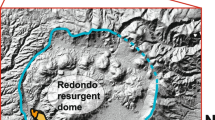Summary
A study of 304 selected biotite analyses, with 17 chemical variables (AlIV, FeIV, AlVI FeVI, Mg, Mn, Ti, Li, Na, K, Rb, Ca, Ba, OH, F, Cl,Θ), was carried out using variation diagrams and statistical methods. It was our aim to verify the existence of characteristic variation patterns in the crystal chemistry of igneous biotites related to the geological setting and chemistry of the parent rocks. In the absence of a range of analyses covering the whole spectrum of igneous rocks, the biotites were grouped “a priori” either as volcanic (rhyolites, rhyodacites and trachyrhyolites, dacites and trachytes, “andesites”, trachybasalts and nephelinites) or as plutonic (granites, granodiorites, tonalites, diorites, “gabbros”). Variation diagrams failed to distinguish clearly between the different groups of biotites; the data overlapped considerably and were accordingly difficult to interpret. Statistical analysis, on the other hand, revealed clear chemical differences; moreover, simple statistical equations and careful coefficients were established which make it possible to evaluate the degree of discrimination between the different groups and to classify unknown biotites. The most important petrological factors affecting biotite chemistry are temperature of crystallization, rock “acidity” and, probably, rock “alkalinity” and the presence of other Fe-Mg minerals. Factors, such as/tf \(f_{H_2 O}\) and\(f_{O_2 }\), can cause more limited variations.
Zusammenfassung
Unter Berücksichtigung von 17 chemischen Variabeln wurde eine statistische und geochemische Auswertung von 304 ausgewählten chemischen Analysen von Biotiten ausgeführt, um die Existenz von charakteristischen Variationsschemata der Kristallchemie der magmatischen Biotite, im Bezug auf geologische Lage und Zusammensetzung des Gastgesteines, zu verifizieren. Da kein vollständiger Analysensatz für die gesamte magmatische Abfolge zur Verfügung war, wurden die Biotite „a priori” entweder als vulkanisch (Rhyolite, Rhyodacite und Trachyrhyolite, Dacite und Trachyte, „Andesite”, Trachybasalte und Nephelinite) oder als plutonisch (Granite, Granodiorite, Tonalite, Diorite, „Gabbros”) gruppiert. Variationsdiagramme allein reichen für eine scharfe Unterscheidung der verschiedenen Biotitgruppen nicht aus. Die Daten überlagerten sich teilweise, so daß jede Interpretation zweifelhaft war. Auf der anderen Seite ergaben sich scharfe chemische Unterschiede aus der statistischen Analyse, außerdem wurden einfache statistische Gleichungen und Koeffizienten, die die Ermittlung des Diskriminationsgrades zwischen verschiedenen Gruppen und die Klassifizierung der Biotite unbekannter Herkunft ermöglichten, festgesetzt. Die wichtigsten petrologischen Faktoren, die den Biotitchemismus beeinflussen, sind die Kristallisationstemperatur, die „Azidität” der Gesteine, und wahrscheinlich auch deren „Alkalinität”, und die Anwesenheit von anderen Mg-Fe-Mineralien. Faktoren wie\(f_{H_2 O}\) und\(f_{O_2 }\) haben nur einen beschränkten Einfluß.
Similar content being viewed by others
References
Alberti A, Brigatti MF (1985) Dependence of chemistry on genesis in zeolites: multivariate analysis of variance and discriminant analysis. Am Min 70: 805–813
Bowen RN, Botbol JM (1975) The Geological Retrieval and Synopsis Program (GRASP). U.S. Geological Survey Professional Paper, 966: 1–87
Brigatti MF, Poppi L, Fabbri A (1986) Corrensites: genetic relationships assessed by multivariate statistical analysis. Bull Min 109: 543–553
Cooley WW, Lohnes PR (1971) Multivariate data analysis. J Wiley & Sons, New York
De Pieri R, Gregnanin A, Piccirillo EM (1978) Trachyte and rhyolite biotites in the Euganean Hills (North-Eastern Italy). N Jb Min A 132: 309–328
——Jobstraibizer PG (1983) Crystal chemistry of biotites from dioritic to granodioritic rocktypes of Adamello Massif (Northern Italy). N Jb Min A 148: 55–82
Gorbatschev R (1970) Distribution of tetrahedral Al and Si in coexisting Biotite and Caamphibole. Contr Min Petr 28: 251–258
Greenland LP, Gottfried D, Tilling RI (1968) Distribution of manganese between coexisting Biotite and Hornblende in plutonic rocks. Geochim Cosmochim Acta 32: 1149–1163
Hazen RM, Wones DR (1972) The effect of cation substitutions on the physical properties of trioctahedral micas. Am Min 57: 103–129
Jobstraibizer PG, De Pieri R (1984) Crystal chemistry of amphiboles from gabbroic to granodioritic rock-type of the Adamello Massif (Northern Italy). Rend SIMP 39: 123–144
Le Maitre RW (1982) Numerical petrology. Elsevier, New York
Morrison DF (1978) Mutlivariate statistical methods. McGraw-Hill, Auckland
Nishiwaki N, Aramaki S, Ui T (1983) Discrimination of areal groups of Japanese Quaternary volcanic rocks using major element chemical analytical data. Computer and Geosciences 9: 487–498
Sokal RR, Sneat PHA (1963) Principles of numerical taxonomy. WH Freeman and Co, San Francisco
Speer A (1984) Micas in igneous rocks. In:Bailey SW (ed) Micas. Mineralogical Society of America, Washington, pp 299–356
SPSS-X Statistical Algorithms (1983) SPSS Inc. Chicago
Author information
Authors and Affiliations
Additional information
With 8 Figures
Rights and permissions
About this article
Cite this article
Brigatti, M.F., Gregnanin, A. Crystal chemistry of igneous rock biotites. Mineralogy and Petrology 37, 323–341 (1987). https://doi.org/10.1007/BF01161824
Received:
Accepted:
Issue Date:
DOI: https://doi.org/10.1007/BF01161824




